By Nick Rains
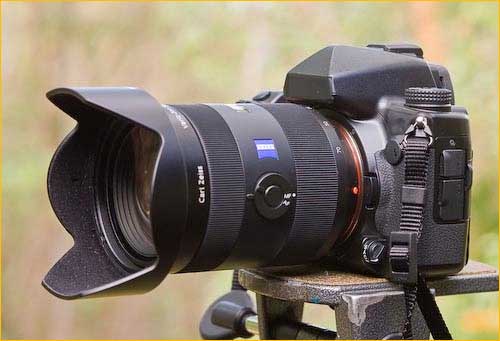
It has been a long wait and rumours have been circulating the photography forums for many months but today Sony has announced the A900, their flagship model which sets a new benchmark with a 24.6 megapixel full frame sensor.
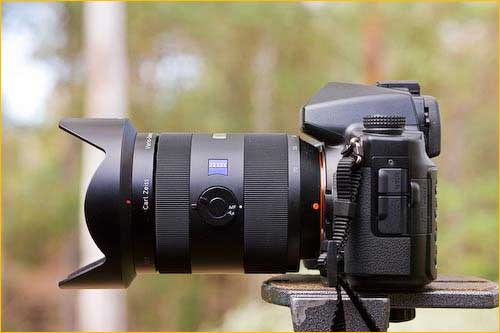
24-70/2.8 on A900 body.
I recently had the opportunity to get my hands on one for a day, along with a Canon 1DsM3 kindly loaned to me by Kayell Queensland. I was able to see for myself how the new camera stacks up against what has up until now been regarded as representing the pinnacle of dSLRs.
The following should be regarded as my opinion only and not a definitive benchtest. Such things are left up to the relevant camera test websites who will go over everything in fine detail. I tend to follow Michael Reichmann’s approach – is this something I personally like and how did it perform in the field?
The camera I had access to was not a full production model, it is possible there will be some firmware changes and other tweaks but I don’t expect anything significant to change.)
So, where to begin? Well, the camera itself seems almost identical to the A700, at least on the outside. Buttons are pretty much in the same place and the overall build quality is very similar. Buttons are weather sealed, the magnesium alloy body is quite light at 850g and the overall impression is of a competent layout. I found that a couple of the buttons were slightly awkward to get at and some are hard to find by touch alone but in general it was an easy camera to use straight out of the box, which is always a good sign.
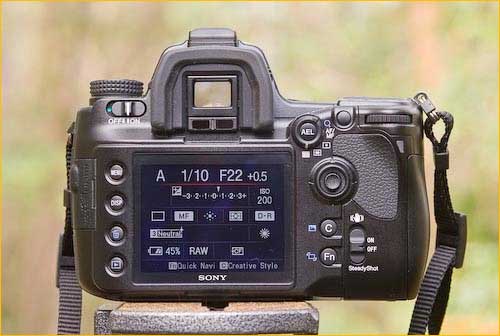
Large rear screen (270dpi)
Some clever and practical features include:
– 3 user-programmable memory modes on the shooting mode dial. You can set 3 different configurations for the camera such as a mirror up, AF-off, manual exposure, stabiliser-off mode for tripod based landscape work and an aperture priority, AF-on, stabilisation-on mode for a walk-around candid stuff.
– Easy to operate mirror up – it’s just another drive mode along with self timer, high-speed, low-speed etc. Very sensible (are you listening Canon?).
– A big, bright rear 270dpi LCD which is orientation-aware so it flips through 90 degrees when you shoot vertically. It’s a pity the same does not happen with the preview image.
– A custom button under your right thumb which can have one of 16 different tasks assigned.
– Sensor cleaning.
– Sensor stabilisation which seems to work fine although I have not tested it specifically.
– Large bright viewfinder, very smooth and focussing is very positive. One up on the Canon here.
– AF micro adjustment which can remember 30 individual lenses, not just the lens types.
– Image preview. This is not Live View but allows you to take a preview shot and then adjust the aperture, shutter and Dynamic Range Optimiser (DRO) to see how the histogram changes. The result is also visually simulated in the preview image.
______________________________________________________________
Handling
In the hand the camera seemed at first a bit unbalanced, the optional grip would have helped a great deal. Since some of the Zeiss lenses are quite ‘fast’ they are necessarily large; the 24-70/2.8 ZA is a big heavy beast at roughly 1000g and this makes the camera very front heavy. Having said that it’s no different to the Canon 24-70/2.8 on a 5D – a big lens on a small body will always be unbalanced.
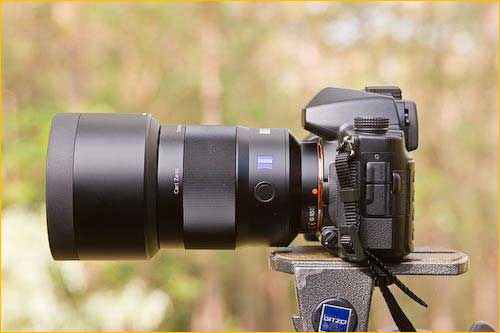
135/1.8 – the lens hood (shown fitted) makes this into quite a big lens.
The only handling gripe I had was that the door to the memory card slots does not open past about 90 degrees making it a bit fiddly to get at the cards. One’s thumb knuckle tends to press against the inside of the door so people with large fingers and/or gloves on, might find it a bit awkward. The Canon doors open well past 90 degrees and the slots are much easier to extract cards from.
In operation the camera is reasonably quick to turn on taking less than 1 second subjectively, certainly less that the time it takes to push the switch and lift the camera to your eye. The shutter sounds very solid, a definite ‘clunk’; but one that sounds, to my ear at least, quite reassuring.
Autofocus is a mixed bag since it depends very much on whichever lens is being used. I was given the 24-70/2.8, the 85/1.4 and the 135/1.8 and the former, being an internal ultrasonic focus system (SSM), was delightful to use – fast, silent and accurate. The 135/1.8 was acceptable, if a little slow but the 85/1.4 was very poor. It sounded like the early AF lenses from a decade ago, whining and whirring before settling, accurately enough, where you want it.
I’d happily use the SSM lenses for fast work but the 85/1.4 and the other non-SSM lenses would be a handicap if relied on for, say, press work. This is a pity because optically the 85/1.4 is awesome; in fact all three lenses I used were sensationally sharp showing all the pedigree of the Zeiss label. The 85/1.4 in particular had wonderful bokeh and was very sharp right across the frame even at F1.4 making it a very desirable portrait lens.
You can see some lens tests here:
http://www.photozone.de/sony-alpha-aps-c-lens-tests
So, what about the sensor – how good is it?
I won’t beat around the bush; it seems to be not quite as good as the 1DsM3 but it’s better in many respects than the current 5D which has more comparable price point.
I say ‘seems to be not quite as good’ since there are some significant caveats to the above rather blunt statement.
______________________________________________________________
Resolution
I shot a series of test images of Brisbane city skyline when the buildings were backlit and therefore low contrast. This should, and did, show up any flaws sometime masked by contrasty light.


I’d call this a draw.
135mm @ F4
I processed the files from the A900 and the 1DsM3, using the equivalent lenses from both systems (Canon 17-40/4, 85/1.8 and 135/2) to the best of the software’s ability and the Canon was marginally superior in detail.
But, and it’s a big but, the Sony RAW processing software (Image data Converter SR V3) is an unknown quantity and lacks much of the sophistication of Adobe Camera RAW and others. It is lightning fast though, on a MacBook Core 2 Duo 2.4 a single file outputs to TIFF in about 3 secs compared with 10 secs for a 1DsM3 file on the same computer in Lightroom.
There is a single sharpness slider which does not seem to do much, plus two more sharpening controls, Overshoot and Undershoot, which evidently work in subtle ways since their effect is not obvious on-screen. The (worryingly thin) manual explains thus: “Adjusts the level to emphasise the outlines in the overshoot direction in adjusting sharpness”. I’m glad that’s clear then.
The point here is that there is no way to compare apples with apples unless I can convert both sets of RAW files in the same software – and the A900 files are not compatible with anything else at this point. All I know right now is that the best I could get out of the Sony software was not quite as good as from the 1DsM3 in ACR.
The Sony specs also indicate a two step noise reduction system, one before a/d conversion and one after. This first step is not user controllable and I see very subtle smudging of fine detail which may be connected to this.
These images show this concern in the grass which looks slightly smudgy on the Sony and also in the cobblestones at the waters edge where the Canon clearly looks more textured.


Canon Sony
The Canon has finer details in organic shapes.
135mm @ F4
There is one ray of light however; if I turn off all sharpening and NR in both software suites, the files look equally ‘bad’. It’s quite possible that the potentially superior demosaicing, NR and sharpening in ACR will draw more detail out of the Sony’s files. We will have to wait and see.
______________________________________________________________
Dynamic Range Optimiser
This is another ‘black box’ solution to dealing with high contrast images. I don’t know what it does exactly, or how it does it, but the end result is an opening of the shadows and a highlight reduction much like the Shadow/Highlight controls in Photoshop. Without being able to compare it directly with other RAW converters it’s hard to say just how good it is but after shooting some high contrast scenes it certainly seems to work pretty well.
These shots show it ‘off’ and ‘Advanced Lvl3’ in-camera, compared to a Canon 5D shot processed with Lightroom defaults. All shots are taken on full auto exposure.
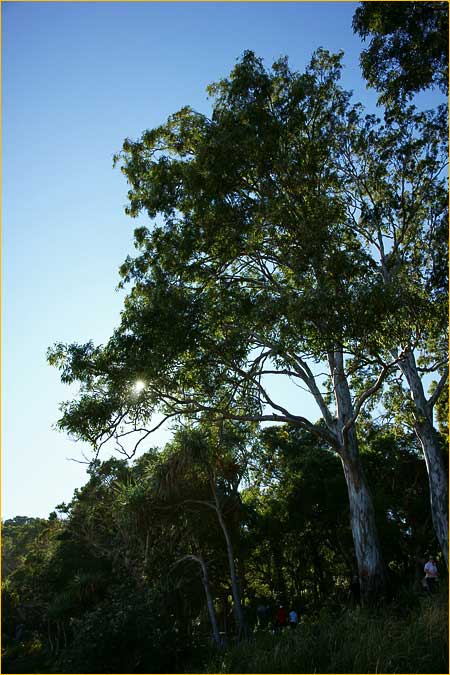
Sony – DRO Off
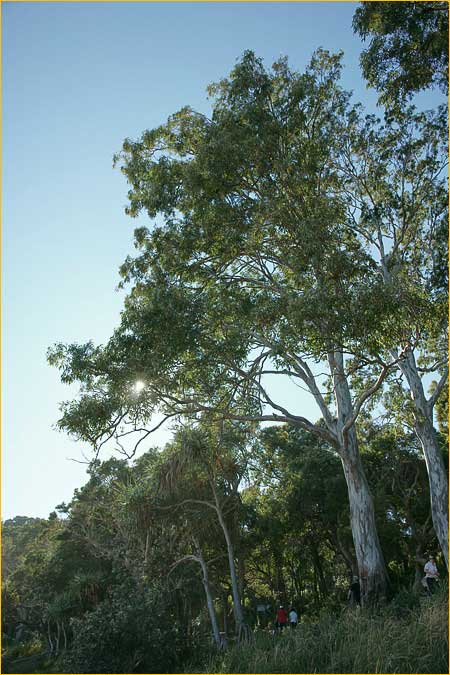
Sony – DRO Advanced Lvl3
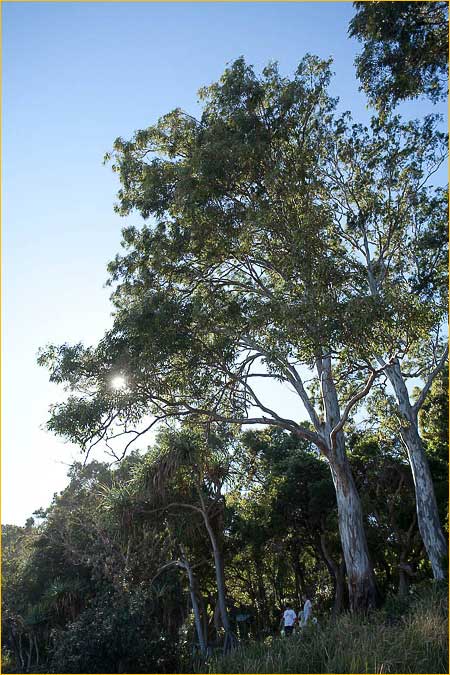
Canon 5D – No adjustment
Looking closely into the shadows there is no apparent noise increase but there is a slight milkyness which I found unsightly. There are three settings for DRO in camera, this was the maximum so maybe the ‘normal’ setting would be better.
It is also interesting that the Sony exposed the shot a 1/2 stop less than the Canon (both cameras were on matrix metering). This effectively kept the sky from washing out and allowing the DRO to pull out a lot of shadow detail.
I’d like to check this out further when the Sony ARW files can be processed in Lightroom or another RAW converter but I suspect the Dynamic Range of this camera is extremely good.
______________________________________________________________
Noise
Comparing the two camera with all NR and Dynamic Range Optimising turned off and at base ISO, the noise levels are very good, in fact very similar to the Canon images. This is pleasing, although some fine detail, as mentioned above, may be masked by the in-camera NR.
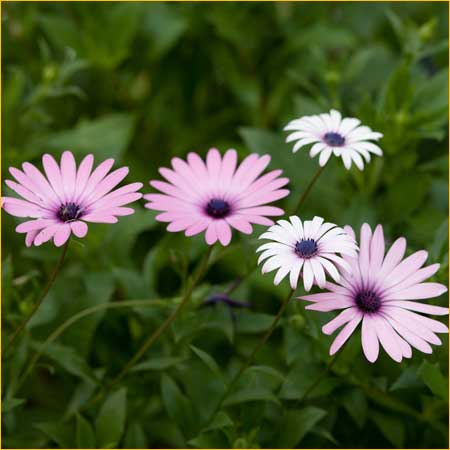
85mm @ F4
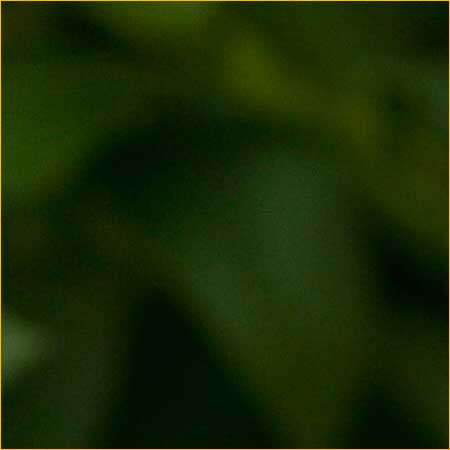
Canon
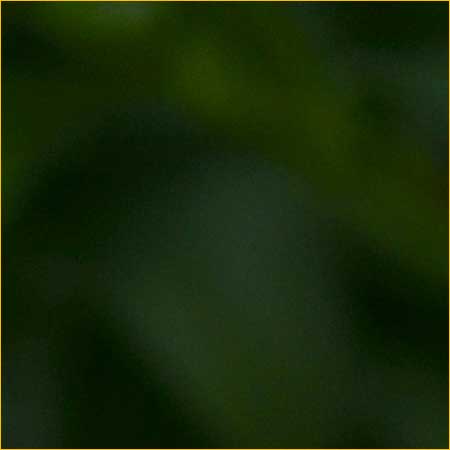
Sony
Due to limited time I only shot a very few frames at higher ISOs and whilst the images looked fine I can’t definitively comment one way or the other.
______________________________________________________________
Colour
For some reason the A900 files are quite unsaturated on default settings. I had to add quite a bit of saturation to get the files to look pleasing. For example, a Sat of +60 (out of 100) was needed to match the colours of Lightroom on the default of 0. This does not seem to be a colour management issue as I first thought, just that the files need a bit of a boost. Once again, when the files can be compared in the same software, then we will know if this is simply a quirk of the Sony software.
There are a variety of ‘Creative Styles’ available, 13 in total. These appear to be much like the Canon Picture Styles and once again there is no clue as to what they actually do, or what settings they affect. The Vivid or Landscape styles partially solve the saturation problem however I’m not comfortable with such an opaque way of working and would prefer to see some way to edit the styles.
______________________________________________________________
The Bottom Line
The estimated price for this camera is AUD3999 for a body-only. Given that this is well under half that of the well regarded Canon 1DsM3, and that the images are very close in quality, then this has to be a great deal. You could buy the body and two top Zeiss lenses for much the same as the Canon.
As far as image quality is concerned, bear in mind that I had to look quite closely at the files – serious pixel-peeping really – to see the differences. I always figure that if I have to look this closely then the differences are probably so close as to be insignificant.
The system is a bit limited, but there are two new lenses, a 16-35/2.8 and a 70-400/4-5.6 both with SSM focussing. The new HVL-F58AM flash looks good too; with it’s unique swivelling head the problems of shooting vertically are overcome by the simple solution of tilting the whole flash head up into a vertical position – very clever.
The lens range is getting wider with the staple zoom lenses available – 16-35/2.8, 24-70/2.8 and 70-200/2.8. The exotics are lacking, no dedicated macro or tilt/shift lens and only one supertelephoto (300/2.8), but whether this is an issue will depend on the photographer. Certainly those lenses that are availably are of top quality optically; this is a priority for many people who want to squeeze the last drop of image quality out of their images.
All things considered I’d have to give this camera a big thumbs up.
September, 2008
______________________________________________________________
Nick Rains
Nick Rains has been photographing landscapes all over the world since leaving University in 1983. In 1986 he spent a year in Perth, Western Australia covering the Americas Cup for a variety of International
magazines such as Yachting World, London Times, and Boat International. Images from this event also appeared in Sports Illustrated, Stern, Paris Match, Regatta and many other well known publications. Over the last 15 years Nick has traveled the length and breadth of Australia covering over 300,000km in his search for fine "Australian" images for the stock photography market. He makes his home in Brisbane, Queensland. Nick is now concentrating on photographic books of his favourite places, the latest project, "Australia’s Hidden Places" will be published by Penguin Books in late 2006. In between outback trips Nick shoots commercial and stock photographs at home and overseas as well as operating his Rainspirit Gallery in the centre of Brisbane. You may also wish to visit Nick’s Web Site, or contact him by e-mail (rains@nickrains.com).
You May Also Enjoy...
Are Museums Destroying Art?
The Impact of ArtI fondly remember the first time I saw the Mona Lisa. It was many years ago at the Louvre Museum in Paris.
